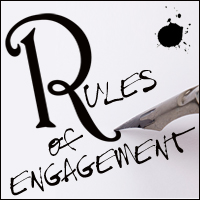.
 A notebook for fiction writers and aspiring novelists. An editor’s perspective.
A notebook for fiction writers and aspiring novelists. An editor’s perspective.
• Next post • Previous post • Index
Finding Your Voice (Part 2):
Do your characters speak to you?
This one gets a little deep, so buckle in. To briefly recap: finding your writer’s voice is a combination of discovering your personality as a writer (See: Finding Your Voice (Part 1) and finding your characters’ fictional personalities. And the best way to discover those fictive voices? Listen.
So, basically, Rule #13 is: Shut up and let your characters tell their own stories. (And in doing so, you’ll discover your voice.)
Crazy, right? It’s a little like channeling Elvis.
As a fiction editor, I can discern—usually within a page or two—whether I’m listening to the writer speak or if I’m listening to the characters tell their own story. And I don’t want the writer’s version of what’s going down, I want the characters revealing themselves. You? You’re just the conduit.
Not that your characters should completely dominate their own fates. The writer’s job is all about forward momentum. Herd these people inside your head—some who may be obstinate, others cranky, some loving, others lazy—incessantly forward. Push that plot dramatically onward. You’re creating a road map from here-to-there, filled with tension and pathos (or emotion or zany humor) and profundity (or frivolity). And each character has an obligation to remain in the confines of the parameters you set.
How do you know that your characters are speaking their minds? Here’s a test. Visualize this hypothetical novel: You’re writing a happy/sad tale about four friends, all very different people from a variety of backgrounds, and each trying to live a life to its fullest.
It’s what I call The Lobster Bisque Variant. Picture these four characters sitting in a restaurant, enjoying the moment. Juan’s a middle-aged Hispanic blue-collar pipe-fitter, Andrea’s a 35-year old airline pilot, Zane is a young black Broadway dancer and Rosanna’s an old Italian grandmother. A waiter comes by and—visualize, in turn, four variations of the following incident—accidentally spills a bowl of lobster bisque in each of their laps. Juan gets the lapful in Version #1, Andrea gets souped in Version #2… and so on. Now, as a writer, describe their reactions.
If your results are:
Version 1/Juan: “Oh my God, how embarrassing. What a mess!”
Version 2/Andrea: “Oh my God, how embarrassing. What a mess!”
Version 3/Zane: “Oh my God, how embarrassing. What a mess!”
Version 4/Rosanna: “Oh my God, how embarrassing. What a mess!”
…then, guess what? You’re not listening to your characters, to the nuance of their unique personalities. You’re listening to yourself, confined to your own theoretical reaction. Ultimately, your characters may become little more than mini-you’s, clones of your boxed-in subconscious, and cookie-cutters of each other. Most readers will quickly detect such similarity, such ambiguity, and most likely find them (and eventually your story) flat and unappealing.
However, by discovering their various reactions to a wet lap can help determine each character’s emotional core. If you like what you hear, then continue (metaphorically, of course) to pour bisque in their laps every so often, careful to interpret and maintain the integrity of their distinct voices. When they speak to you, through you (and, believe me, they will) be aware of their cadence and vocabulary and motivation. A great novel, after all, isn’t about plot—it’s about people. (Also see Dialogue.)
And so… voice? It’s partly your storytelling ability. And partly about each character’s unique emotional energy. Strip away voice and whatever’s left—however realistic, however meticulously constructed—feels dry, lifeless, vacant. He did this, she did that. I went here. I went there. A house on Main Street. It rained. John loved Mary.
Instead, allow your characters to reveal the passion that burns inside their souls. Give them sufficient room, sufficient stage time, to become real to both you and your readers.
.
• Next post • Previous post • Index
.
.